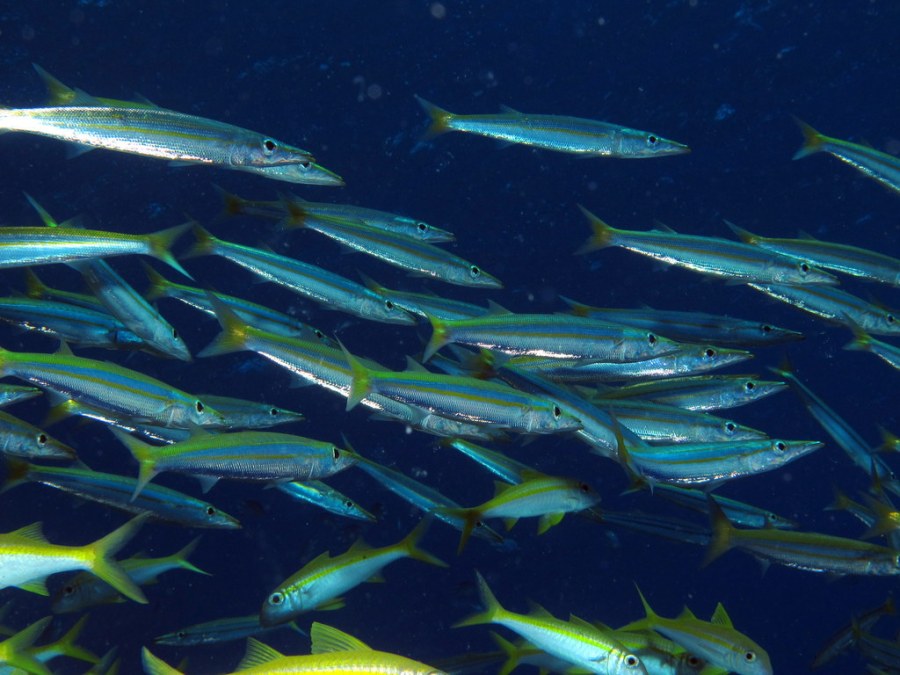How Much Money Can You Make Tuna Fishing

In that location are unlike stages of a young fish's life. They are referred to past many names throughout the first years of their survival. Depending on the species will determine what stages and names a baby fish are referenced by. This can include egg, yolk-sac larvae, fry, and juvenile before reaching maturity.
Reproduction
At that place are three ways for a fish to reproduce. This is either through livebearing, which is similar to the manner humans and other mammals produce their young, spawning, or self-bearing.
Spawning is the process when the female fish releases her eggs. The eggs are either deposited directly into the h2o, where they float around, or into a nest. This depends on the blazon of fish species. The male fish will then fertilize the eggs with milt that they release. Non all eggs that are laid will be fertilized. Depending on the species of fish, the fish will spawn every year, every four years or just once in their lifetime before dying.
Some fish can switch genders. This allows them to complete the unabridged process of reproduction themselves. This procedure is besides known equally self-begetting.
Fertilized eggs hatch in two to eight days, depending on the species of fish. The majority of eggs don't reach maturity due to the unlike threats they face. Some of these threats include the change in water temperature that can occur due to the changing seasons during spawning. Oxygen levels changing in the water is another common threat to fertilized fish eggs. Flooding and sedimentation that comport the eggs to unhealthy areas or cause them to become landlocked will preclude the egg from hatching. Predators and disease are a constant threat to fish at all stages of their lifecycle.
Larvae
The larvae stage for a baby fish begins 9 to 18 days subsequently the egg has hatched. This is also called the yolk-sac stage as the yolk-sac stays attached to the baby fish once it is hatched. This yolk-sac provides the young fish with the nutrients it needs to grow within its environment. Some species of fish, such as the catfish, do not go through this stage.
The larvae phase of the infant fish'south life lasts i to two weeks. During this time, it feeds off the yolk-sac while staying at the bottom of the h2o. When in the larvae stage, many species of fish tend to settle inside the plants and other caverns at the bottom of the water for protection. This helps them blend in and hide from predators as they don't have fins for swimming and are classified as gratuitous floaters.
Fry
As a fry, a young fish still has its yolk-sac attached, only it begins to diminish in size. The fry phase lasts for two to five days for most types of fish. The fry will stay at the bottom of the water during this time. However, it does begin to explore its new surround, coming out of hiding for short periods of time. Most of a fry'south nutrition comes from the remaining yolk-sac, just it volition begin feeding on food lying at the bottom of the h2o's bed.
Juvenile
Equally with each stage of a fish'due south life cycle, the amount of time the baby fish remains a juvenile depends on its species. This stage may last upwards to three years. The juvenile fish begins to develop its fins, and their gills mature throughout this phase. Juvenile fish are not able to reproduce. The beginning of the juvenile stage is crucial to the fish's survival, as it must learn how to survive among its predators, find enough food to survive and gain its independence in all other aspects.
Source: https://www.reference.com/pets-animals/baby-fish-called-4c866748e10f2345?utm_content=params%3Ao%3D740005%26ad%3DdirN%26qo%3DserpIndex
Posted by: jamesgrele1966.blogspot.com

0 Response to "How Much Money Can You Make Tuna Fishing"
Post a Comment